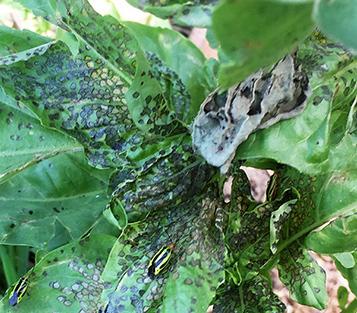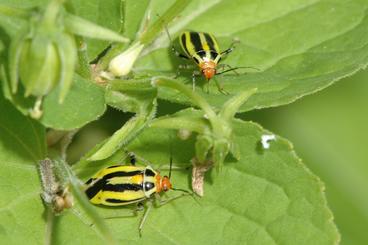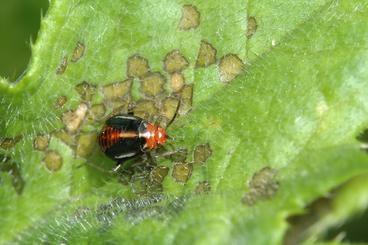E.C. Burkness and W.D. Hutchison
Department of Entomology, University of Minnesota
Introduction

Fourlined plant bug, Poecilocapsus lineatus, is a common insect found in Minnesota. It has an extensive host range, feeding on over 250 species of plants including ornamental plants, vegetables including cucurbits, potatoes, and peppers, and herbs such as mint and basil. The associated damage consists of spots that look similar to fungal disease spot and can be misidentified as such. Damage is inflicted by the bug's piercing-sucking mouthparts and is usually not severe enough to cause plant death.
Biology & Life Cycle
Fourlined plant bug adults are greenish-yellow with four black strips running longitudinally down the wings. The head is orange-brown and the legs are yellow-green. During the fall, the banana shaped eggs are laid at right angles in vertical slits measuring 2 to 3 inches along the plant stem. They are usually not laid individually but instead are laid in groups of six or more. The eggs will over winter and hatch in May or early June just after the plant's foliage emerges.
Nymphs are a bright red to orange color with black dots on the abdomen. Later instars have black wing pads running ½ way down the abdomen with a yellow strip on each wing pad. Nymphs will remain near their hatching site and feed on the upper side of leaves removing the plant's chlorophyll. After advancing through five molts in a period of about six weeks, the fourlined plant bug will have matured to an adult form. Adults will feed, moving from plant to plant, for approximately one month before mating; adults will not overwinter, and there is only one generation per year.


Damage
With piercing-sucking mouthparts, the fourlined plant bug removes the plant's chlorophyll leaving a window of upper and lower epidermis. A toxin present in their saliva is also secreted during feeding that digests the components responsible for holding the plant cells together. This feeding produces white, dark, or translucent spots 1/16 to 1/8 inch in diameter on plant leaves, which can merge together if there is substantial damage forming large blotches. Entire leaves can turn brown, curl up and eventually fall off. If feeding occurs on new growth, wilting may result.
The distinctive spots created by fourlined plant bug feeding may be misidentified as fungal disease spots because of their comparable appearances. The agility of this bug contributes to this misidentification because when disturbed, the four-lined plant bug will drop to the ground or will hide and is therefore rarely seen. In addition, when the damaged portion of the leaf fall out, a shot hole will remain that looks similar to fungal disease.
In most cases, fourlined plant bug feeding only affects the appearance of plants, however, heavy infestations can result in entire shoot tips become severely wilted and new growth may curl with distortion or die.
Management
Begin to check plants in mid-spring around May and June for damage caused by the fourlined plant bug. Net sweeps may be useful in detecting the presence of the pest. Use control at the first sign of damage since only a few bugs can cause severe damage. Insecticidal soaps and dormant or summer horticultural oils prove useful. Also, if it is feasible, handpicking stems to remove the eggs is effective. The eggs are highly visible and can be easily disposed of in the fall or early spring when foliage is absent. Spray in May and June if the associated damage is observed and there is considerable feeding damage. To ensure proper use of insecticides, refer to the most recent edition of the Midwest Vegetable Production Guide.
The use of a trap crop is another possible control method to keep the four-lined plant bug away from the crop. Mint is highly attractive to this pest and can be effectively used as a trap crop. The fourlined plant bugs will choose to feed on the mint instead of other nearby plants. Place a barrier, such as a tile, around the mint to prevent the spread of roots. Once the crop is large enough to withstand damage caused by this pest, the mint can be removed. This technique has not been tested in heavy infestation situations and may not prove to be beneficial in this case.
References
Cohen, A.C and A.G. Wheeler. Role of Saliva in the Highly Destructive Four-lined Plant Bug (Hemiptera:miridae).
https://academic.oup.com/aesa/article-abstract/91/1/94/52107/Role-of-Saliva-in-the-Highly-Destructive-Fourlined?redirectedFrom=PDF
Cornell University. 2003. Vegetable Disease ID and Management http://vegetablemdonline.ppath.cornell.edu/
Hiskes, R. Four-lined Plant Bug.
Krischik, V. and J. Davidson. 1999. Fourlined Plant Bug Life History.
Metcalf, R.L. & R.A. Metcalf. 1993. Destructive and Useful Insects. 5th Edition. Insects Injurious to Cucurbits. McGraw-Hill, Inc. New York.
Schooley, J. 2000. Insects that Affect Ginseng.